Archive Record
Images
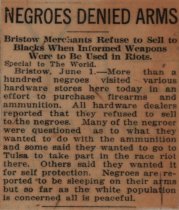
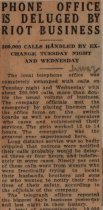




Additional Images [32]

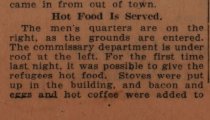
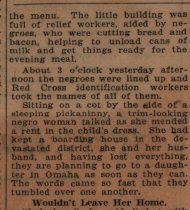


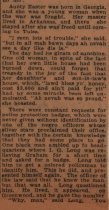
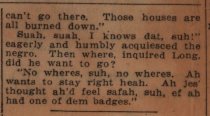

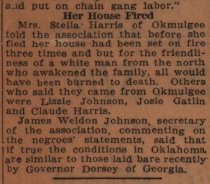



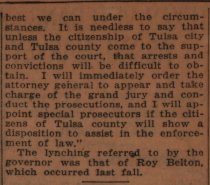
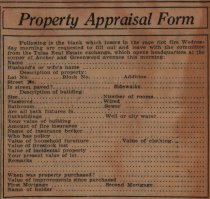





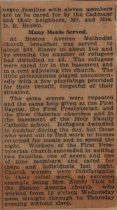



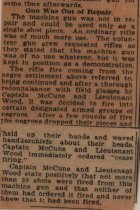



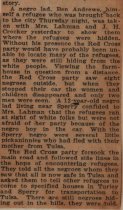


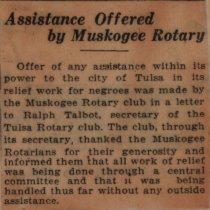
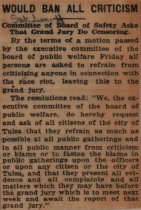
Metadata
Catalog Number |
2012.050.263 |
Object Name |
Clipping, Newspaper |
Date |
06/02/1921 |
Scope & Content |
Eleven newspaper clippings from the Tulsa Daily World published June 2-4, 1921, and attached to an album page. The first clipping, published June 2 is entitled "Negroes Denied Arms." This article reports that merchants in Bristow, OK, refused to sell arms and ammunition to African Americans on June 1, 1921. When asked why they were purchasing the items, some African Americans gave the reply that they intended to go to Tulsa, OK, to take part in the "race riot." The second newspaper clipping, published June 2, 1921, is entitled "Phone Office Is Deluged By Riot Business." This article reports that the telephone office in Tulsa, OK, placed more than double the number of usual calls during the time of the Tulsa "Race Riot" on the evening of May 31, 1921 and the following day, June 1, 1921. The office counted approximately 300,000 calls during this period. The article also states that the Western Union telegraph office sent 10,000 messages during the same period. The manager of the office, H. B. Gale, reported that a telegraph substation will be established at the fairgrounds for the convenience of the African American detained there. The third newspaper clipping, published June 3, 1921, is entitled "Order Replaces Chaos In Camp." This article reports upon the atmosphere within the old fairgrounds on June 2, 1921, where African Americans are detained following the Tulsa Race Massacre. The report states that approximately 1,000 African American men, women, and children are in camp and that the atmosphere is peaceful. The article reports that Newt Graham the supervisor of the camp, stated that the Red Cross had to organized the camp and run it without the assistance of aid until troops arrived on Thursday, June 2. The article also mentions a shortage of supplies on hand, as well as the organization of the camp into men's quarters, women's and children's quarters, and a commissary. The report includes an interview with an African American women in which she provides first-hand information concerning the destruction of African American homes and property. A second article on this clipping is entitled "Charges Peonage Near Okmulgee." This article claims that eight African Americans fled Oklahoma to New York City due to threats being tacked to the doors of their homes. Four of the African Americans fled from in or near Okmulgee, OK. The article reports upon the unfair peonage system and the loss of land for African American farmers and sharecroppers. The article contains the names of the individuals from Okmulgee. A third article on this clipping is entitled "Rule By Guards Is Made Easier." The article fragment, reports on more lenient martial law orders for the night of Thursday, June 2 than for the previous night. The article also reports that Colonel Ewell L. Head will be in charge of the troops in Tulsa with headquarters at City Hall. The article reports upon the issuance of Field Order No. 3 by Major Byron Kirkpatrick, which forbade funeral of riot victims from being held inside church buildings. The report states that "wild rumors" continue to circulate through the city. The article also reports upon the verbal orders from Adjutant General Charles F. Barrett for the arrest of African American hotel owner J. B. Stradford. The article ends with the text of a letter from Oklahoma Governor Robertson to Judge Valjean Biddison imploring the judge to convene a grand jury to investigate the "race riot." A fourth article on this clipping is entitled "Property Appraisal Form." The Tulsa Real Estate Exchange requested all property owners and tenants who lost property in the "race riot fires" to fill in this blank form. For the newspaper article that described the blank form, see newspaper clipping 1984.002.088. A fifth article on this clipping is entitled "Citizens To Help Rebuild 'Little Africa.'" This article reports the formation of the Public Welfare Committee on Thursday, June 2, 1921 to help with the relief efforts following the Tulsa Race Massacre. The article lists the names of the committee members and states that " Tulsa's law-abiding citizens and business men will rebuild the homes destroyed in Little Africa during the race riots." The committee also began a campaign soliciting funds for relief and rehabilitation for African Americans. The report states that members of the Tulsa Real Estate Exchange will appraise the destroyed property in the burned African American community. This article also includes a tally of the casualties [deaths] of the Tulsa Race Massacre, which numbers twenty-eight individuals: eighteen African Americans and ten Caucasians. The fourth newspaper clipping, published June 3, 1921, is entitled "Tulsa Churches In Mercy Work; Feed and Care for Many Negroes Left Homeless by Riots." This article refers to the churches within Tulsa providing shelter, clothing, and meals for victims of the 1921 Tulsa Race Massacre. The report states that the basement of the First Methodist Church was converted into a center for the wounded where volunteer doctors and nurses attended the patients. They attended patient Seth Holts, who received burns during the fires. Another church, Boston Avenue Methodist, served meals and cared for refugees in the church basement and in a tent on the grounds. Other churches listed in the article as providing assistance include the following: First Baptist Church, First Presbyterian Church, and First Christian Church, and in the basement of the Holy Family Catholic School. The fifth newspaper clipping, published June 4, 1921, is entitled "Rooney Explains Guard Operation; Reports Use of Machine Gun by His Command on Standpipe Hill; Weapon Was Useless; In View on Hill to Frighten Negroes in Valley and was Fired Few Times." This article reports the use of a machine gun on Standpipe Hill during the 1921 Tulsa Race Massacre by the members of the local national guardsmen. Lieutenant Colonel L. J. F. Rooney stated that the machine gun was placed on the hill in an effort to frighten and control the African American community. He stated that the machine gun did not work properly, could only fire one bullet at a time, and was fired by guardsmen about twenty times altogether. Rooney states that the gun was provided to him for use by Tulsa Police Department Major C. W. Daley. The article provides a full description by Tooney of the gun's placement and use by local guardsmen prior to the arrival of the Oklahoma National Guard under the supervision of Adjutant General Charles F. Barrett. The sixth newspaper clipping, published June 4, 1921, is entitled "All Refugees In Detention Camps: City Churches Cleared of Riot Victims and Jobs Found for Many." This article reports that the last of the African American refugees of the Tulsa Race Massacre in the shelter of city churches left on June 3, 1921, and were interned in the detention camp at the fairgrounds or were transferred to the homes of their employers. These individuals included about 100 African Americans sheltered at the Holy Family Cathedral. The seventh newspaper clipping, published June 4, 1921, is entitled "1,000 Men Available." This article reports that 1,000 ex-service men are available if needed in case of emergency to restore order following the 1921 Tulsa Race Massacre. Three hundred of the men are uniformed and currently patrolling the city street under the command of Major Theodore Hopkins, post service officer and first vice commander. The posts at Cleveland, Drumright, and Broken Arrow, OK also sent men. On Friday, June 3, 1921, fifty ex-service men were sworn into service under command of Tulsa Police Commissioner James M. Adkison. The eighth newspaper clipping, published June 4, 1921, is entitled "Many Refugees Hiding in Hills; Difficulty Found by Red Cross in Rounding Up Frightened Victims." This article reports that many African American victims of the 1921 Tulsa Race Massacre fled to the hills near Sperry, OK, following the disaster. Reporter Mrs. Charles E. Lahman reported that one fleeing girl drown while crossing a creek near Sperry on Wednesday morning, June 1. The article details the difficulty faced by the staff of the American Red Cross to locate refugees. The ninth newspaper clipping, published June 4, 1921, is entitled "Fine Vandal Who Admits Offense." This article reports that Judge H. J. Gray fined C. D. Dodson twenty-five dollars for looting the home of Dr. R. T. Bridgewater during the Tulsa Race Massacre. The report states that many vandals looted homes of African Americans on Wednesday morning, June 1, 1921 prior to the arrival of the Oklahoma National Guard in Tulsa. Other people salvaged items from African American homes to keep the property from being stolen. These items were turned over to law enforcement. The article states that a large room at the courthouse is filled with furniture which has been recovered. The tenth newspaper clipping, published June 4, 1921, is entitled ""Assistance Offered by Muskogee Rotary." This article reports that the Muskogee Rotary Club offered assistance with the relief work for African Americans following the 1921 Tulsa Race Massacre. Ralph Talbot, the secretary of the Tulsa Rotary Club responded to the offer by stating that "relief was being done through a central committee and that it was being handled thus far without any outside assistance." The eleventh newspaper clipping, published June 4, 1921, is entitled ""Would Ban All Criticism; Committee of Board of Safety Asks That Grand Jury Do Censoring." This article states that the executive committee of the Board of Public Welfare passed a resolution that asked all citizens of Tulsa, OK to refrain from public gatherings and refrain from criticizing the City of Tulsa or any public official with regard to the "race riot." |
Search Terms |
American Legion arrests Blacks Booker T. Washington high School Boston Avenue Methodist Episcopal Church Bristow, OK churches detention fairgrounds firearms fires First Baptist Church First Christian Church First Presbyterian Church funerals grand juries Greenwood District Hold Family Catholic School Holy Family Catholic Church & Holy Family Cathedral looters & looting machine guns Muskogee Rotary Club National Association for the Advancement of Colored People "NAACP" North Detroit Avenue Oklahoma National Guard Okmulgee, OK relief efforts Rotary Club of Tulsa sharecroppers Sperry, OK St. Vincent de Paul Society Standpipe Hill telephone companies Tulsa Board of Public Welfare Tulsa Race Massacre Tulsa Real Estate Exchange veterans western attire Western Union Telegraph Company |
People |
Abel, J. W. Adkison, James M. Andrews, Ben Avery, Cyrus Stevens Barrett, Charles F. Biddison, Valjean Bridgewater, R. T. Brown, D. B. Corey, Bertha Crocker, J. H. Crum, Rolfe Pomeroy Daley, C. W. Dodson, C. D. Dunlap, Roy Frost, C. H. Gale, H. B. Gatlin, Josie Graham, Newton Robert Gray, H. J. Harris, Claude Harris, Stella Head, Ewell L. Holts, Seth Hopkins, Charles Fowler Hopkins, Theodore Johnson, E. Fred Johnson, James Weldon Johnson, Lizzie Kennedy, Samuel Grant Lahman, Charles E. Long, I. G. Martin, Loyal J. McCullough, Grant R. Robertson, James Brooks Ayers Rooney, L. J. F. Seeber, C. J. Smith, Easter Standeven, Herbert Leslie Sunday, Billy Talbot, Ralph Tyrrell, H. C. Vick, Elmer |
